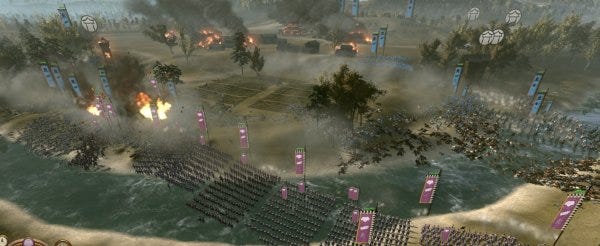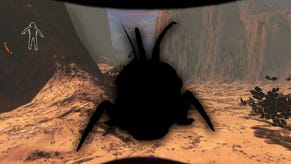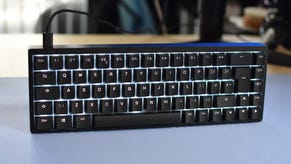First Look: Shogun 2 – Fall of the Samurai
The Way of the Gun
Fall of the Samurai, a standalone expansion for Shogun 2, is the most modern Total War game yet – and quite possibly one of the most fascinating. It’s the tale of what happened when Japan met the West – where the industrial revolution and social turmoil that had been brewing in other nations for centuries was suddenly played out in the space of twenty years.
“We’ve never really done anything quite like this.” explains Lead Battle Designer Jamie Ferguson as he sets out the stall for his project. “It’s all of the periods we’ve ever done, piled into one game. It shows you how truth is stranger than fiction. We’re making a game that has gatling guns and samurais, then ironclads with torpedoes fighting against wooden warships with archers…”
The game’s campaign opens in 1869 – right at the outset of the Boshin War. Also known as The War of the Year of the Dragon, this was a civil war that would prove to be the birth pangs of modern Japan. “Japan was really going through the shock of the new,” explains Lead Game Designer James Russell. “The Americans turned up, and after that more Westerners, and they saw that Japan had been lagging behind in a feudal state.”

Soon after this, then, the ruling Tokugawa Shogunate had been strong-armed into lopsided deals with the West – while growing discontent at rapid modernisation was running rampant, especially among the vast (and largely unoccupied) warriors of the Samurai caste. It wasn’t long before nobles from the Chosu, Satsuma and Tosa domains began to make their feelings known – especially about (that old chestnut!) getting the Emperor back in power.
“The Imperial faction began with a reaction against the fact that the Shogunate was letting all these foreigners in.” continues Russell. “Their slogan was ‘Revere the Emperor. Expel the Barbarian’. It’s the battle for the soul of Japan. They could only become effective, though, by using western technology themselves.”

On the battlefield then, with factories smoking in the mid-distance, affairs have shifted up several gears. You’ll begin with basic spear and matchlock units, before moving up the scale of mechanical death-bringing with pistol and rifle-bearing cavalry and infantry – eventually buying in Gatling and Armstrong guns from America to give your foes a taste of just how horrid the next few hundred years of warfare are going to be.
The ‘field of fire’ combat covered by Total Wars Empire and Napoleon is returning then, rebuilt from scratch, but this time battlefields will also be far more infused with the tenets of traditional combat. Well-trained spearmen and swordsmen flanking hastily trained peasants with rifles is a powerful tactic, while Samurai melee rush attacks see slow-moving and expensive weaponry wiped from the battlefield in an instant.
In fact, those fancying a challenge could even choose against racing up the chain of cannons and thereby abandoning the old ways. The more modern your faction becomes the more unrest must be dealt with on the campaign map, and the less effective Samurais become. As such those playing with traditional sensibilities do have some elements in their favour – even if their battle tactics will have to be slightly more guerrilla. You’d have to fire arrows over hilltops, for example, to keep out of the sightlines of your enemy’s more horizontal bullets.

Nailing this balance between old and new seems vital to the folks at Creative Assembly, and as such they’re also making sure that MP bouts between the increasingly mechanised Boshin-era and the original Shogun 2’s Sengoku Samurai will be a nuanced and balanced affair rather than an inevitable whitewash.
Liable to become something of a guilty pleasure for office-chair generals, meanwhile, is the ability to get in direct control of the game’s more explosive armaments. Your correspondent, for example, descended into control of a Gatling gun with a tap of the ‘H’ button and watched bodies crumple and blood-clouds form as he mowed down a unit of approaching swordsmen. No, it wasn’t deep strategy – but crikey it felt good. The rub is that when you’re aiming a cannon at the gate of a heavily armoured castle (then watching as the camera flies along behind your launched projectile) you can’t exactly concentrate on the troops being overwhelmed elsewhere. The feeling of power, however, is almost worth the casualties.
The war on land has changed then, not least because the number of units that can be corralled into battle has doubled to a suitably epic forty on each side. The war at sea, meanwhile, now also makes its presence known during battles on foot. Keeping your ships anchored close to the battlefield will mean that you’ll be able to call in (hugely inaccurate) bombardments on the rough position of the enemy. Sure, these may well end up doing nothing but dislodging some turf (or perhaps killing your own general) but are part of CA’s mission to make naval warfare mix into your campaign with far more fluidity.

Your ships can also can rain death and destruction down onto armies and cities alike on the campaign map – while coastal defences can be set up in anticipation of your enemy pulling the same trick. In naval battles, meanwhile, you can expect to hear the crackle of musket-fire between ships – but also the very earliest form of torpedoes slowly edging towards your vessels beneath the water with a menacingly languid wake following after.
The campaign map proper becomes more and more tinged by modernity as the years tick by. The hand-painted map shroud has now been replaced by a printed one – and as it pulls back cities begin to sprawl, hazes of smoke appear and even the music that serenades your warmongering gains an increasingly Western lilt. At one point steam trains will even start to run through your central provinces – meaning that troops can suddenly be flung to the other side of Japan in the space of a mere turn.
The cost of progress is that your populace will resist change. Creating key buildings and technologies will see your level of modernity increase, unlocking new tiers in the tech tree as it does so, but will rile your people in much the same way that hunger did in the original Shogun 2. A lot is happening to Japan in a very short time-frame (so short, in fact, that every year is now covered by 24 turns) and with Fall of the Samurai Creative Assembly are intent on showing social change just as much as new and exciting ways to perish on the battlefield.

To aid Japan’s metamorphosis, meanwhile, come three new units. The Imperial political activist known as the Ishen-Shishi, the established Shogun regime’s Shinsengumi secret policeman and Tom Cruise. Well, he’s technically called the Foreign Veteran – but he’s a character that’s a bit like Tom Cruise out of The Last Samurai anyway. He can harass enemy forces, generate experience when attached to an army, improve a city’s troop production and even do one-on-one battle with enemy generals while your fingers ready themselves to load up a recent save should he die horribly. He’s awesome, in short, and made even better by the fact that his British variation mutters “I say! What, what?” when you boss him about.
The final flourish will come when you either declare your final allegiance to the Emperor or the Shogun, prompting all the other clans to flock to their chosen side so the final act can play out. Alternatively, you could pull a Shogun 2 – call dibs on a republic and fend off all-comers. Whatever the outcome, and whether or not you let the Samurai truly fall, or instead stumble around a little bit, this looks to be a mighty treatment of a tempestuous slice of the world timeline. “It’s the ideal Total War setting,” underlines Creative Assembly’s Jamie Ferguson with all the necessary gravitas. “History provides you with everything that you need.”
Fall Of The Samurai will arrive on 23rd March 2012.









